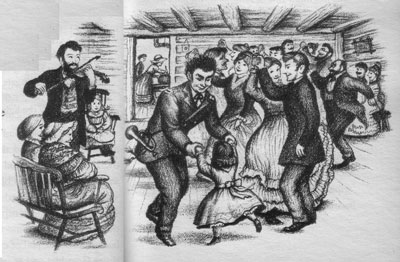
Dances in Hunt County were similar to the sketch above. However, the clothing is somewhat fancier and the cabin is larger. But everyone seems to enjoy the festivities. (humbke.com)
Imagine going to a dance at the Courthouse, a dance that lasted for two or three days and nights. A dance held in a space with no furniture, only a bare floor and a few cane-backed chairs or wooden benches. A dance where everyone came, bringing food, drink, children and even babies. All participated in the festivities.
Dancing was one of the few amusements that both men and women enjoyed. It was an opportunity to visit, to dance, to meet new folks and reacquaint yourself with old friends seldom seen. Music usually came from a fiddle. Sometimes, a man with a mouth harp joined in. Musical instruments were small and easy to transport on foot, or on horseback, but rarely in a wagon. Many times, in the South, the musician or musicians were slaves who had a natural talent for music.
Not all dances were held at the courthouse. Most were in homes, several miles away from neighbors. Because there was little furniture in those log cabins, it was easy to take a table and chairs out under a tree where food was spread out. Some homes had puncheon or wooden floors, but most floors were nothing but swept dirt.
Dances took place at weddings, elections, funerals, or just for fun. When guests were so tired they could hardly stand up, they eyed up the situation and spied a place to lie down and go to sleep. And, it didn’t necessarily mean a comfortable bed. When they awoke refreshed, they picked a partner and continued dancing. Children joined in with adults. No one went home until the fiddler stopped.
Dances were popular here in Hunt County from the beginning in 1847 until the Civil War. After the war, dances continued until about the time the railroads arrived in 1880. But on the Texas frontier west of Fort Worth, these dances continued into the 20th Century. If there were not enough women and girls, men danced with men and thought nothing of it.
On December 24, 1860 six men decided to “manage” or host a Cotillion. Two of the men were single, three were married, and one seems to have been a widower. Handwritten invitations were delivered to everyone within a day’s ride of town. On the day of the event, the town was filled with people. Since a Cotillion means a dance honoring young ladies between sixteen and eighteen, it was THE social event of the season. No further details are available, but based on similar Cotillions there was delicious food, some liquor, fancy clothes from the local mercantile stores or handmade, and available musicians. The affair was held in the District Courtroom of the first brick courthouse built in 1857. It was also the last such event that occurred for more than a decade. Ominous war clouds loomed in the sky, but this was an evening of fun and peace between differing political sides.
Now skip ahead to the second decade of the twenty-first century. If you are familiar with our courthouse, we have two district courtrooms and two County-Court-At-Law courtrooms, along with a Commissioners Court in the previous jail on Johnson Street. Could we dance in any of those? Well, it would be difficult. Judge Aiken has the largest space, but everything is bolted to the floor. All are really too small to invite the entire county into town for a dance. So much for having a county dance.
